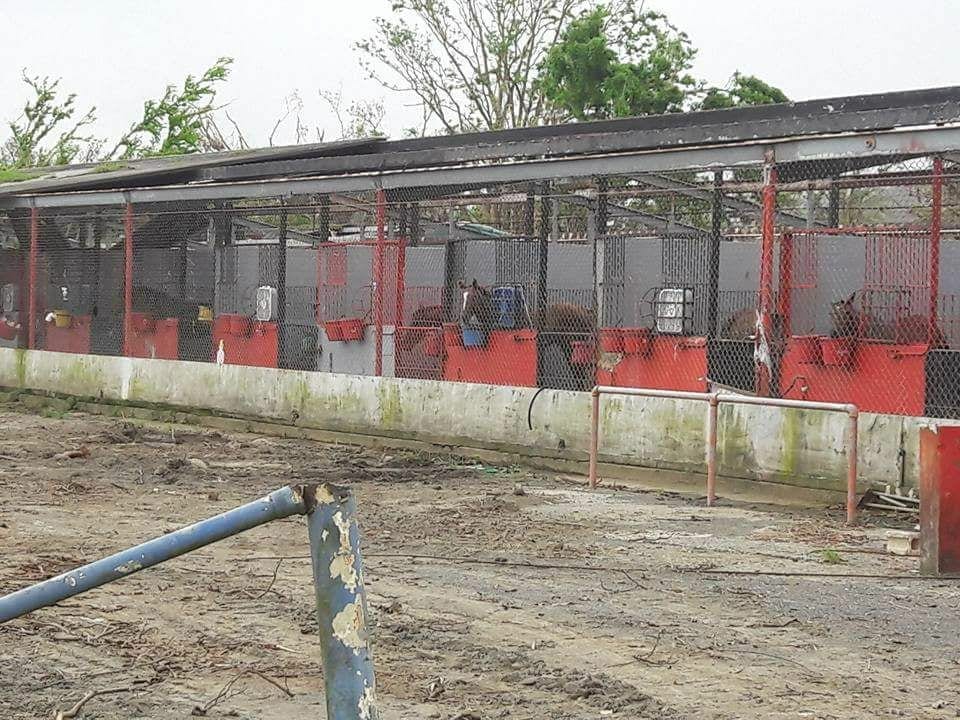At Camarero, a “chaotic” situation, and murky future

Roofless barns are one of many challenges at hurricane-ravaged Camarero race track.
This post was updated 11:30 a.m. on October 17, 2017.
by Linda Dougherty
When Hurricane Maria swept over Puerto Rico as a Category 5 storm September 20, it nearly destroyed the island. It was a natural disaster of such magnitude that it’s caused extreme suffering for both the island’s human and equine inhabitants.
The island’s only racetrack, Hipodromo Camarero, located east of San Juan, was severely damaged, with upwards of 80 percent of the barns ripped apart by Maria’s deadly winds. Since the storm hit, getting food, water and bedding to horses has been difficult; more than 15 thoroughbreds have already died from colic, founder, injuries and infection — despite the efforts of rescue groups and volunteers,
According to one owner, management at Camarero is intent on resuming racing in mid-November but has done little to repair the track’s facilities.
“The situation is abusive and chaotic,” said the owner, who asked not to be named. “Three weeks later and no roofs have been installed on barns by track management. They don’t even care to help, and they won’t do anything. All they do is talk about resume racing.”
“Things are improving, but there are still horses in barns without roofs,” said Shelley Blodgett, the co-founder and co-director of Caribbean Thoroughbred Aftercare, Inc., a 501(c)(3) organization that works to rescue and retire horses based at Camarero. Within the last week, she said, the group has placed eight Camarero horses into quarantine for retirement in the United States while working with Old Friends and The Exceller Fund, among them Winning Dubai (96 starts), Rodriguito (150 starts), and Salientito (125 starts).
CTA’s Kelley Stobie has been working tirelessly at Camarero since the hurricane, giving food and water to more than 100 horses, including some that had been abandoned by their owners, and also coordinating supplies. Other groups assisting in the effort are the Thoroughbred Charities of America, Thoroughbred Retirement Foundation and The Jockey Club.
Blodgett also noted that recent rains have made the situation even worse for horses stabled in barns without roofs.
“They received 50 tarps to use as temporary roofs, and some horses have been moved to empty stalls with roofs,” she said. “The ones without roofs are generally on concrete and/or muck as any shavings put down are washed away and soaked. The track is open for training, and mostly it’s the horses planning to be entered in the Classico Del Caribe at Gulfstream Park (in December) that are training. While Camarero is saying it’s planning to resume racing sometime in November, others in the industry believe a three-to-six month timeframe on restarting racing is more realistic, given what horses have been through and the state of the backstretch.”
José A. Maymó Azize, of the Administration of Industry and Equestrian Sport of Puerto Rico, a government organization that oversees horse racing at Camarero, released a statement October 11.
“As you know, Camarero was devastated,” the statement reads. “We still do not have an official final report on the damage assessment and as we have been informed, negotiations continue with the insurance companies of the racecourse.”
Maymo Azize said the main problems facing horsemen are delays in repairing the stable area; a lack of shelter or reasonable accommodation for horses; irregularity in the availability of water; abandonment or neglect of horses by a few owners and/or trainers; the health of horses (directly related to the first three points), and poor logistics in the delivery and/or distribution of food and bedding.
He stated that the structure of the entire horse racing industry was disrupted, but that they were working to resolve the situation.
Calls to Camarero management were unable to go through.
“FEMA response has been very weak,” said Juan Ramirez, a former owner and self-described whistleblower who has been closely following the situation at Camarero and whose Facebook page includes numerous photos of the devastation. “Another issue is that management hasn’t been able to pay purses for the last days that there was actual racing. Between Hurricanes Irma and Maria, they only raced a few days and have not been able to pay that money.”
In Puerto Rico, about 600 off-track betting facilities generate nearly 95 percent of the money that is bet on horse racing, with just a handful of people actually attending the races at Camarero, which was racing five days each week.
A law legalizing Video Lottery Terminals was passed in 2010, and since then they’ve generated about $120 million a year for the racetrack. In order for Camarero to operate the VLTs, it must conduct live racing, with the storm disrupting that revenue source. According to Ramirez, management at Camarero is seeking permission from the government to begin operating VLTs without conducting racing so it can start making money.
Ramirez said that owners and trainers are going through a very difficult time in the wake of the hurricanes.
“They are trying to keep their horses healthy,” he said. “There is a severe communication problem and they don’t know what to do. They don’t know whether to get rid of their horses – just send them somewhere. Hurricane Maria basically destroyed the clubhouse, and all the facilities were severely affected.”
Ramirez also doubts that racing can resume in mid-November, and said that it’s believed that date was given so that horses won’t be sent back to the United States to race.
All in all, it’s left a chaotic situation that has owners and trainers struggling to figure out how to feed and shelter their horses.
“My horse is okay,” Albert Davila, an owner at the track, said. “I’ve managed to feed him well and his barn has a roof, but not all are that lucky.”







